Welcome to BFS,
BFS believes a good coach must have a good theoretical knowledge of training. This has lead to the development of our study materials to help you understand the basic concepts of the BFS Program. The following two pages will introduce you to all of the items in your Certification Package.
BFS also strongly recommends that you purchase the BFS Safety and Liability Package if you haven’t done so already. Follow the BFS Magazine blog to keep up with current developments in your profession and to enjoy the inspirational stories published every issue.
Thank you for taking this important step in achieving your coaching goals and becoming a part of BFS.
Sincerely,
The BFS Team
Bigger Faster Stronger, Inc.
The BFS Study Guide uses a multimedia learning approach for maximum understanding of the BFS Program. Watch the videos and read the WRSC Resource Book
In the Study Guide you will be given a summary of the material covered, learning objectives, a list of key terms used, a pre-test, and references for supplementary material for more detailed information on the topics covered.
When you’ve completed each Part in the Study Guide, check your pre-test responses with the specific sections in the WRSC Resource Book and review the material.
Bigger Faster Stronger: This classic publication covers the history of the BFS Program and provides an excellent overview of the program. The BFS Total Program book, called simply Bigger Faster Stronger, is professionally designed and well illustrated with more than 300 photos. It covers the following topics:
The Total Program, Strength Exercises, Flexibility, Speed and Agility, Program Administration, Plyometrics
Access Supplementary materials referenced in the BFS Study guide online here. You can always access over 1,700 articles on everything from training to motivation here.
This Study Guide contains direct links to dozens of articles that are available on the BFS Archives for free and spanning over 45 years of information on increasing the effectiveness and safety of the weight room environment.
Set Rep Log Books
Record keeping is key to continued success in the weight room, so it’s important to have training logs for your athletes. BFS Set Rep Log Books provide areas for an individual athlete to record his or her progress and the personal records achieved while using the BFS Program.
Be An Eleven Guidebook for Success
One important aspect of the BFS Program is character education. The Be An Eleven Guidebook for Success helps all teens, especially those involved with athletics, not only cope with but also thrive in today’s world. It gives teens who want to be great—and those who want to be leaders—a better chance to do so.
BFS SAFETY PACKAGE
We also recommend that you purchase the BFS Safety Package. The BFS Safety Package will show you how to help prevent weight room injuries and give you the tools to help you, and the organizations you represent, avoid and win lawsuits. Begin with the BFS Safety and Liabilty Manual free for download here.
Summary: A unified approach to strength and conditioning is the best way to train large groups of athletes, especially multi-sport athletes at and below the high school level.
Learning Objectives
• Define the concept of unification
• Explain why multi-sport athletes perform better with a unification program
• Learn 20 benefits to having elementary-school-age athletes involved in a unification program such as BFS
• Understand why a unified program might be better for a college sports program
• Be able to list basic equipment needed for a unified program
• Be able to discuss the benefits and limitations of computerized workouts versus logbooks in a unified program
Key Terms
Unification
Multi-Sport Athlete
Off-Season
In-Season
Computer Workouts
BFS TOTAL PROGRAM RESOURCES:
Video 1-0: “Introduction”
WRSC Resource Book
BFS ONLINE ARCHIVES:
• BFS High School of the Year
• Two for the Price of One at Weyauwega-Fremont High
• The Evolution of the BFS Revolution
• Focusing on Success at Southern Oregon University
• Why Women Need BFS
• Year-Round Unification Program
• Why BFS Schools Win
• The BFS Total Program
Use the printable answer sheet to follow along as you take the course: ANSWER SHEET
1. Define the concept of unification as it relates to athletic programs.
2. Name several components of a total conditioning program for athletes.
3. How does a unification program prevent territorial struggles between coaches and athletes?
4. What school athletic programs can use a unified program? Select one:
A) College
B) High School
C) Junior High School
D) All the above
5. Name five benefits Coach Bob Giesey gave for encouraging elementary-school-age athletes to get involved in a weight training program such as BFS:
1)
2)
3)
4)
5)
6. Name one reason a college might find a unification program of value.
7. When training beginning and/or female athletes, what type of equipment is of particular value in teaching Olympic lifts?
8. List two advantages that a computerized workout program has over a training logbook.
1)
2)
Summary: Variety is one of the most important principles to ensure continual progress in strength training. Changes in reps, sets, exercises and intensity can provide such variety in workout programs.
Learning Objectives
• Learn the importance of variety in strength training
• Learn a practical format for organizing sets and reps in a long-term workout plan
• Describe Hans Selye Stress Syndrome and how it relates to strength training
• Be able to list seven practical ways to motivate athletes to continue training
• Explain several drawbacks of periodization models
• Outline a basic program varying sets and reps
• Be able to write warm-up sets for weight training exercises
Key Terms
Hans Selye Stress Syndrome
Periodization
Set-Rep Rotational System
Supplementary Materials
BFS TOTAL PROGRAM RESOURCES:
Video 2-3: “The Off-Season Outline”
Video 2-4: “The BFS Set-Rep System”
BFS ONLINE RESOURCES:
WRSC Resource Book
• The Truth about Periodization
• How Good is Good? Bring Relevance to Achievements
• Sets and Reps
• The BFS Set-Rep System Step by Step
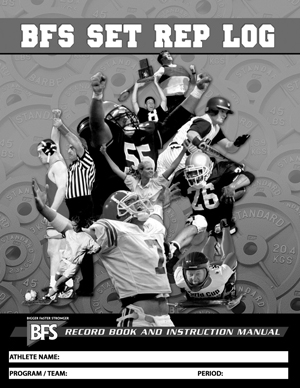 Training logs enable athletes to keep track of their progress on a daily basis.
Training logs enable athletes to keep track of their progress on a daily basis.
Use the printable answer sheet to follow along as you take the course: ANSWER SHEET
9. Many workout programs fail because their exercise prescriptions are so monotonous that the body adapts to them: True or False?
10. Which of the following phases are not included in Hans Selye’s Stress Syndrome: Shock, Countershock, Stage of Resistance, Progression, Stage of Exhaustion?
11. Using charts for motivation is one way to prolong the stage of resistance. Name two more ways.
12. List two reasons that a periodization program may be impractical for most high school athletic programs.
1)
2)
13. What two core lifts in the BFS Program should not be performed for more than 5 reps?
Summary: To help athletes fulfill their physical potential and perform at their best during the sport season, an aggressive strength training program must be performed during the season.
Learning Objectives
• Learn the importance of strength training in-season
• Be able to list five basic ingredients of a sound in-season program
• Learn how a multi-sport athlete should sequence off-season and in-season workouts in a year-round program
Key Terms
In-Season Training
Volume
Intensity
BFS TOTAL PROGRAM RESOURCES:
Video 2-4, “The In-Season Program” Set Warm-ups, Rep Records, Set Records
WRSC Resource Book
BFS ONLINE ARCHIVES:
• Break Over 10 Records Every Day All Year Long
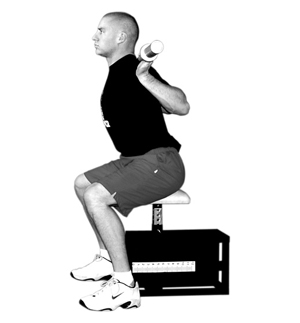 The box squat enables athletes to maintain their lower body strength
The box squat enables athletes to maintain their lower body strength
Use the printable answer sheet to follow along as you take the course: ANSWER SHEET
14. According to a research study published in Medicine and Science in Sports, how long could a subject retain strength if they reduced volume by two-thirds but kept intensity high? Select one:
3 weeks,
5 weeks,
15 weeks.
15. During in-season training, should an athlete train two times a week or just once per week?
16. During the season, is it better to lift in the morning or after practice?
17. Should auxiliary exercises be performed during the season?
18. In football, should an athlete lift during two-a-day practices?
Summary: To give athletes a head start, conditioning programs can be implemented in elementary school programs
Learning Objectives
• Understand both the benefits and risks of having young athletes lift weights
• Learn the appropriate ages for young athletes, both male and female, to begin lifting weights
Key Terms
In-Season Training
Volume
Intensity
BFS TOTAL PROGRAM RESOURCES:
Video 2-3: “BFS Sets and Reps”
WRSC Resource Book
BFS ONLINE ARCHIVES:
• “124 Reasons Why Weight Training is Safe for Young Athletes,”
• “The Future of Youth Gymnastics,”
• “Youth Weightlifting Pioneer Marty Schnorf,”
• “Is Weight Training Safe for Kids?”
• “Morenci Middle School,”
• “The BFS Readiness Program,”
• “Conceive It, Believe It, Achieve It!” (Whitewater Middle School),
• “Product Review: The Aluma-Lite Bar”
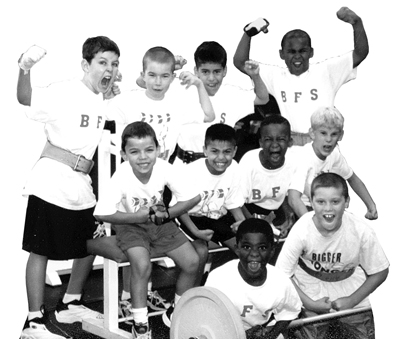 Young athletes get a head start to athletic excellence with the BFS Readiness Program:
Young athletes get a head start to athletic excellence with the BFS Readiness Program:
Use the printable answer sheet to follow along as you take the course: ANSWER SHEET
19. What is the grade level at which students in physical education classes most commonly begin the BFS readiness program? Select one:
6th grade,
7th grade,
8th grade.
20. Is premature closing of the epiphysial (growth) plates related primarily to injuries or to hormonal influences?
21. According to sport scientist Mel Siff, Ph.D., can running, jumping, striking or catching impose greater forces on the musculoskeletal system than heavy weight training?
22. Youngsters who compete in Olympic-style weightlifting competitions have higher bone densities than children who do not lift weights: True or False?
23. According to research published in the November/December 2001 issue of the Journal of American Academy of Orthopaedic Surgeons, injuries from bicycling were greater than the number of injuries from weightlifting by what percentage? Select one:
50 percent,
100 percent,
400 percent.
24. If a high school male athlete cannot squat 145 pounds to parallel, what program should he begin with? Select one:
The BFS Readiness Program,
The regular BFS Program.
25. How long should a basic plyometric program last in the BFS readiness program? Select one:
10 minutes, twice a week;
15 minutes, three times a week
20 minutes, twice a week
26. What two things must happen before progressing to heavier weights in the BFS readiness program?
Summary: The Six Absolutes are six training principles that help teach perfect technique in sport and weight training. The Six Absolutes are as follows:
1) Use an athletic or jump stance, 2) Be tall, 3) Spread the chest, 4) Align the toes, 5) Align the knees, and 6) Keep your eyes on target.
Learning Objectives
• Develop a common terminology when teaching weight training and sport skills
• Be able to define the Six Absolutes
• Be able to give examples of the Six Absolutes in sport techniques and weight training exercises
Key Terms
Bodybuilding Stance
Power-Lifting Stance
Athletic Stance
BFS TOTAL PROGRAM RESOURCES:
Video 1: 1-1, “The Six Absolutes”
WRSC Resource Book
BFS ONLINE RESOURCES:
• A Closer Look at the Six Absolutes
• The 6 Absolutes Book
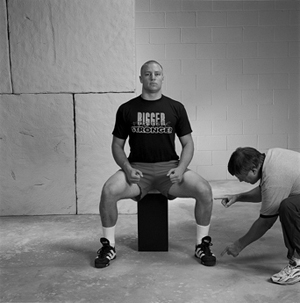 Coaching the Six Absolutes in the box squat
Coaching the Six Absolutes in the box squat
Use the printable answer sheet to follow along as you take the course: ANSWER SHEET
27. What aesthetic benefits can be derived from applying the concept of “being tall”?
28. “Spreading the chest” and what other concept go hand in hand? Select one:
Assume a neutral spine position,
Lock in the lower back,
Stabilize the trunk.
29. In the BFS hip-flexor stretch, what does “toes aligned” mean? Select one:
The toes should point straight ahead,
The toes should point slightly out.
30. The eyes always be slightly above horizontal in weight training exercises such as the squat and the power clean weights: True or False?
Summary: The parallel squat is the foundation for athletic excellence and will balance the development between the hamstrings and quadriceps. The upper thigh must be parallel to the ground at the bottom of the squat to optimally develop leg and hip strength for speed and power.
Learning Objectives
• Understand why the squat is such an effective exercise
• Learn how to teach the parallel squat
• Understand the value of several squat variations and how to teach them
• Learn the effects of squats on the knees and the controversy surrounding this topic
• Be able to recognize and correct two of the most common mistakes in squatting technique
• Learn proper spotting techniques for the squat and squat variations
• Understand the value of squat devices such as the Sting Ray and lifting chains
Key Terms
Anterior Cruciate Ligament
Vastus Medialis
Sticking Point
Lifting Chains
BFS TOTAL PROGRAM RESOURCES:
Video 1-2: Squat Variations - “The Box Squat” “The Front Squat” “Other Squat Variations”
Video 1-3: “The Parallel Squat”
BFS ONLINE ARCHIVES:
WRSC Resource Book
• “The Low Box Squat”
• “Spotting the Squat”
• “He Can’t Squat, … Flexibility,”
• “Knee Safety”
• “Let’s Talk Box Squat”
• “Ouch! Shoulders and Squatting”
• “Box Squat? The First Thing We Do!”
• “Box Squat Advantages”
• “True Parallel”
• “Box Squat Warning”
• “The Green Bay Box Squat”
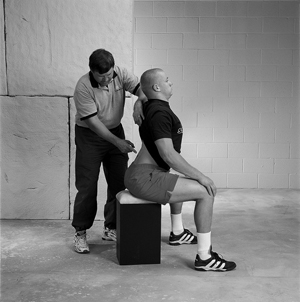
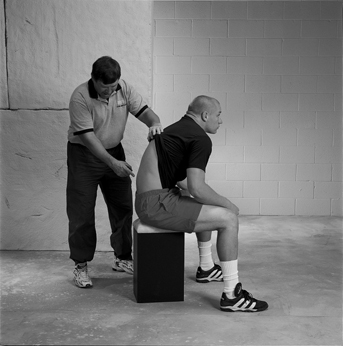
Pointing out the difference between bad form (left photo) and perfect form (right photo) in the box squat.
Use the printable answer sheet to follow along as you take the course: ANSWER SHEET
31. The parallel squat builds the foundation for great speed, regardless of the size of the athlete:
True or False?
32. Achieving at least a parallel depth in the squat makes the lower-body muscles stronger and bigger, especially the quadriceps and hamstrings. Name three other benefits to going parallel.
33. Not having the knees aligned in the squat often places harmful stress on which ligament of the knee?
34. What is one advantage during the squat in holding the barbell with the thumbs around the bar?
35. In addition to helping the athlete when they cannot complete a lift, what is another function of spotters?
36. Athletes should limit the amount of weight they box squat to no more than 200 pounds above their best parallel squat:
True or False?
37. What lower-body muscle does the front squat place extra emphasis on?
38. When using lifting chains, generally you should add about 25 percent at the finish position of the lift:
True or False?
Summary: The power clean is of vital importance. It develops explosiveness. When done correctly, every muscle will be fired in proper sequence, executing a maximum summation of force. It is essential for optimum levels of jumping, throwing, hitting, and sprinting starts.
Learning Objectives
• Understand why quick lifts such as the power clean are vital exercises for athletes
• Understand the relationship between jumping ability and the power clean
• Learn how to teach the power clean
• Understand the benefits of several quick lift variations and how to teach them
Key Terms
Quick Lifts
Rotary Hip Movement
Multijoint Movement
Explosive Jump Phase
Hang Clean
Power Snatch
Hang Power Snatch
BFS TOTAL PROGRAM DVD:
Video 1-5: “The Power Clean”
Video 3-2, “Advanced Power Cleans”
BFS ONLINE ARCHIVES:
WRSC Resource Book
• “Jim Schmitz’s Weightlifting Legacy”
• “Born to Lift, Casey Burgener”
• “Just Jump to Clean”
• “A Few Words with America’s Strongest Man”
• “Three Power Clean Drills”
• “Michael Butler”
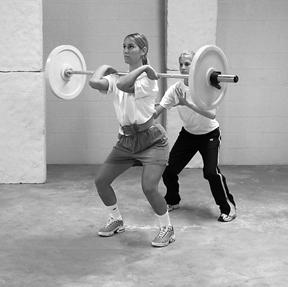 The Power Clean develops explosiveness and jumping power.
The Power Clean develops explosiveness and jumping power.
Use the printable answer sheet to follow along as you take the course: ANSWER SHEET
39. What is the most popular quick lift?
40. The rotary hip movement simulates what action in athletics?
41. When does the prestretch occur during a power clean or power snatch?
42. What foot stance is used when pulling the barbell off the floor in the power clean?
43. What foot stance is used when racking the barbell in the power clean?
44. What is meant by the “hang” position when referring to the power clean or power snatch?
Summary: The deadlift and the Hex bar deadlift develop the lower back, trunk, hips, glutes, hamstrings and quadriceps. The deadlift is performed with a standard barbell. The Hex bar deadlift is performed with a hexagonal-shaped barbell with handgrips placed on the sides that allow the athlete to perform exercises from inside the encompassing bar. This unique design makes it easier to maintain perfect form when performing the deadlift exercise.
Learning Objectives
• Understand why the deadlift or Hex bar deadlift should be a core exercise in a total conditioning program for athletes
• Learn the advantages of a Hex bar deadlift, and why the Hex bar was designed as it was
• Learn how to perform the deadlift and the Hex bar deadlift
• Learn how to spot a conventional deadlift
• Learn the benefits of the two forms of straight-leg deadlifts and how to perform them
Key Terms
Hex Barbell
Power Line
BFS TOTAL PROGRAM RESOURCES:
Video 1-6 “The Hex Bar”
BFS ONLINE ARCHIVES:
WRSC Resource Book A Closer Look at the Straight-Leg Deadlift
• “The BFS Straight-Leg Deadlift” 2002
• “The Hex Bar” 1998
• “Mega Hex, Hex, Hi-Hex – Which One for My Program?” 2001
• “The Straight-Leg Deadlift” 2000
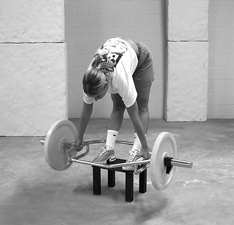 The straight-leg dead lift can also be performed with a Hex Bar
The straight-leg dead lift can also be performed with a Hex Bar
Use the printable answer sheet to follow along as you take the course: ANSWER SHEET
45. What is a power line in regard to deadlift performance?
46. What muscles does a deadlift strengthen?
47. What are the advantages of a Hex bar deadlift over a straight-bar deadlift?
48. What is the advantage of performing a straight-leg deadlift on a platform?
49. Generally, how much weight should a junior high school boy or girl use in a straight-leg deadlift? Select one:
45 pounds,
85 pounds,
at least 100 pounds.
50. What is the hand position of the spotter on a spotted deadlift?
Summary: The bench press and its many variations are great exercises for developing overall strength in the upper body, especially the chest, shoulders and triceps. The bench press is especially important for women, as they carry proportionately less muscle mass in their upper bodies than men and this gap in strength often compromises their ability to play sports at a high level.
Learning Objectives
• Learn which muscles the bench press emphasizes
• Understand how variations in grip and bench angle affect the results of the bench press
• Understand why the bench press is the most dangerous exercise in the weight room
• Learn the advantages of the towel bench press and how to perform it
• Learn the advantages of using lifting chains with the bench press and how to use them
Key Terms
C Curve
BFS TOTAL PROGRAM VIDEO:
Video 1-4 , “The Bench Press”
Video 1-4 “The Towel Bench”
BFS ONLINE ARCHIVES:
• “A Closer Look at the Unilateral Power Press”
• “The Towel Bench”
• “Spotting the Bench Press”
• “The Towel Bench”
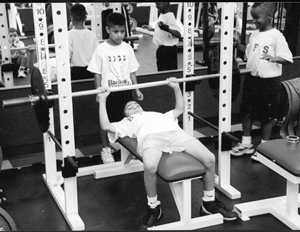 The spotters and a power rack ensure maximum safety with the bench press
The spotters and a power rack ensure maximum safety with the bench press
Use the printable answer sheet to follow along as you take the course: ANSWER SHEET
51. What are three of the major muscle groups that a bench press works?
52. Why is the bench press especially important for female athletes?
53. What are the BFS standards for women? Select one series:
100, 200 and 300;
100, 120 and 140;
100, 150, 200 and 250 pounds.
54. How can the position of the eyes help you determine if the body is properly positioned on a bench press?
55. Should there be an arch in the lower back when performing the bench press?
56. What muscles does a close grip emphasize in a bench press?
57. What bench angle is generally used to perform an incline bench press?
58. The bench press, with chains, can be used as a substitute for the towel bench press: True or False?
Summary: Auxiliary lifts are performed after the BFS core lifts to emphasize specific muscle groups. There are two types of auxiliary lifts: standard and advanced. Standard auxiliary lifts are relatively safe, easy to perform and require less coaching than advanced auxiliary lifts.
Learning Objectives
• Understand the purpose of auxiliary lifts
• Recognize how several auxiliary exercises can help prevent injuries
• Be able to distinguish between standard and advanced auxiliary lifts
• Learn where auxiliary lifts should be placed in a program and how much they should be emphasized in regard to reps and sets
• Learn the performance of several standard and advanced auxiliary lifts
• Learn the value, performance and teaching sequence of power balance drills
Key Terms
Standard Auxiliary Lift
Advanced Auxiliary Lift
Power Balance Drills
BFS TOTAL PROGRAM RESOURCES:
Video 1-7, “Auxiliary Exercises”
Video 3-4, “Advanced Auxiliary Lifts”
BFS ONLINE ARCHIVES:
• “Run Faster, Jump Higher … Reverse Hyper” 2008
• “Preventing Injuries with the Glute-Ham” 2002
• “New BFS Total Program Concept” 2003
• “Glute-Ham Power” 2002
• “Discover the Glute-Ham Advantage” 1997
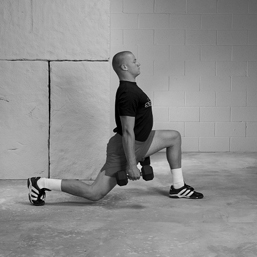 Many auxiliary lifts, such as lunges, can be performed with dumbbells
Many auxiliary lifts, such as lunges, can be performed with dumbbells
Use the printable answer sheet to follow along as you take the course: ANSWER SHEET
59. How many sets are usually performed for auxiliary exercises? Select one:
2 sets,
3 sets,
4 or more sets.
60. How many auxiliary lifts should usually be performed each week? Select one: five or fewer exercises, seven exercises, eight exercises.
61. What are the negative effects of placing too much emphasis on auxiliary exercises?
62. Selection of auxiliary lifts depends on choosing those that will help you win or prevent specific injuries: True or False?
63. What are two sports that would benefit most from the athlete performing a neck exercise as an auxiliary lift?
Summary: To train harder and prevent muscle pulls, athletes need to warm up before sprinting, stretching or lifting heavy weights. The BFS Dot Drill not only helps an athlete warm up quickly but also develops agility.
Learning Objectives
• Understand the importance of a proper warm-up before sprinting, stretching or lifting heavy weights
• Learn how to design a Dot Drill station and how to perform the Dot Drill workout
• Learn Dot Drill standards for both male and female athletes
Key Terms
Aerobic Exercise
Dot Drill
Dot Drill Pad
BFS TOTAL PROGRAM RESOURCES:
Disc 2: Part 2, “The BFS Dot Drill”
BFS ONLINE ARCHIVES:
• “A Closer Look at the BFS Dot Drill,” 2008
• “A Fun Challenge (Agility Drills),” 2000
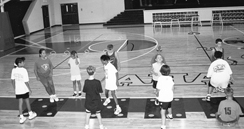 The Dot Drill can be performed in a group setting
The Dot Drill can be performed in a group setting
Use the printable answer sheet to follow along as you take the course: ANSWER SHEET
64. Why should an athlete warm up?
65. What is the advantage of performing a Dot Drill warm-up versus a simple aerobic exercise such as jogging?
66. What is the proper sequence of a Dot Drill workout?
67. The first goal in Dot Drill training is to commit to performing the drills six times a week. What is the second goal?
Summary: Plyometrics can be an excellent training method to increase speed, jumping ability and explosiveness. Box jumps are an excellent way to incorporate plyometrics into a training program and can be performed as part of the BFS Readiness Program.
Learning Objectives
• Understand the value of plyometrics in helping athletes fulfill their physical potential
• Learn the best way to design a plyometric jump box
• Learn the five phases of the BFS plyometric program
• Learn how to measure progress in a plyometric program
Key Terms
Plyometrics
Vertical Jump
Box Jumping
Bounding
BFS TOTAL PROGRAM RESOURCES:
Video 2-6, “The Plyometric Program”
BFS ONLINE ARCHIVES:
• A Closer Look at Box Jumping
• “Lateral Plyometrics” 2003
• “Plyometric Box Jumping, What You Must Know” 2001
• “Plyometric Box Jumping” 2000
• “Shock It to Me with Plyometrics” 1998
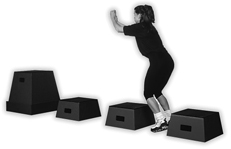 When setting up plyo boxes, the last box should be the highest
When setting up plyo boxes, the last box should be the highest
Use the printable answer sheet to follow along as you take the course: ANSWER SHEET
68. Best results in increasing vertical jump performance come from combining squatting and plyometrics, rather than performing each type of training by itself: True or False?
69. What is the major drawback to performing box jumps on an open plyometric box versus on a solid box?
70. In a box jumping workout using five boxes, which box should be the highest? Select one:
first box,
second box,
fifth box.
71. Name two types of plyometric bounding drills.
1)
2)
Summary: Speed workouts should be performed twice a week, year-round, and athletes should be frequently tested. Sprint training takes 10 minutes and consists of 5 minutes of technique work and 5 minutes of fast sprinting. Significant improvements in sprinting form can be attained by following the BFS eight-point sprint technique system.
Learning Objectives
• Learn how to incorporate sprint training into a weekly conditioning program
• Understand the importance of video analysis in sprint training
• Learn 10 ways to improve speed
• Understand the importance of a good start in sprinting and the position of the hands, feet and head for a good sprint start
• Learn the eight points of good sprinting
Key Terms
Video Analysis
Modified BFS Track Stance
BFS TOTAL PROGRAM RESOURCES:
Vidoe 2-5, “The Speed Program”
BFS ONLINE ARCHIVES:
• “Speed Skating with the Stars” 2006
• “Get Really Fast” 2003
• “The World’s Fastest Teenager” 2003
• “LSU Tigers, On the Fast Track with Denis Saver” 2002
• “Michelle Freeman, The Woman Who Ran Too Fast” 2002
• “Angela Williams, Fast Track to Fame” 2001
• “Resistance is Not Futile – Speed Parachutes’ 2001
• “Speed Kills” (Featuring Eugene Robinson)” 2000
• “The Need for Speed” 2000
• “Devine Leg Power” 1999
• “Measuring Success, Just Jump or Run” 1999
• “Tiffany Lot, 55 Meter Hurdles World Record Holder”1999
• “From Slow to Fast, From a 5.7 forty to a 4.6” 1998
• “The Start” 1998
• “Thirteen, The Need for Speed” 1996
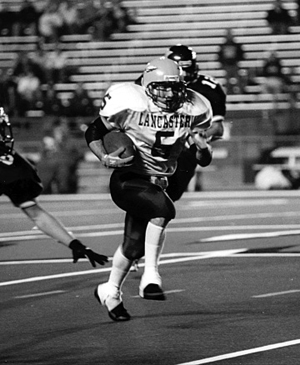 Speed is the key in many sports, especially football
Speed is the key in many sports, especially football
Use the printable answer sheet to follow along as you take the course: ANSWER SHEET
72. During the off-season, generally the best days to perform sprint training are Tuesday and Thursday: True or False?
73. When athletes are tested on either a 40-yard or 20-yard sprint, how many timed sprints should they perform? Select one:
one timed sprint,
two timed sprints,
three timed sprints.
74. What is the value of video analysis in sprint training?
75. BFS offers 10 ways to improve speed; one way is to perform plyometrics twice per week. Name four more ways.
1)
2)
3)
4)
76. Where should your feet be in the modified BFS track stance?
77. In the eight-point BFS sprint technique system, one technique that enables you to run faster is to point your toes straight ahead. Name three more techniques
Summary: The BFS 1-2-3-4 Flexibility Program goes beyond injury prevention and rehabilitation, as it is designed to improve speed and jumping power. BFS regards stretching as a separate exercise regimen, not as part of a warm-up or cool-down for physical activity. Stretching should be performed daily and requires concentration and adherence to proper technique
Learning Objectives
• Understand how stretching can improve speed and jumping power
• Learn how to incorporate stretching into a weekly conditioning program
• Learn nine basic principles of proper stretching
• Learn the proper sequence and performance of 10 stretches designed to work the major muscle groups
• Learn a simple way to measure progress in stretching and what would be considered good standards for both male and female athletes
Key Terms
Static Stretching,
Muscle Tension,
Cool-Down
BFS TOTAL PROGRAM RESOURCES:
Video 2-2, “Flexibility Training”
BFS ONLINE ARCHIVES:
• “A Closer Look at the BFS Flexibility Program” 2008
• “Flexibility: Is it Part of Your Program?,” 2001
• “Stretching for Speed,” 1998
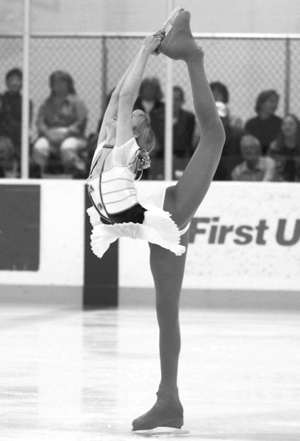 Many sports require exceptional levels of flexibility as demonstrated by Kristen Hasselmeier
Many sports require exceptional levels of flexibility as demonstrated by Kristen Hasselmeier
Use the printable answer sheet to follow along as you take the course: ANSWER SHEET
78. How is the BFS approach to stretching different from most other stretching programs in regard to its focus?
79. Stretching should be a part of a warm-up program for sport activities: True or False?
80. What is meant by the term “balance” in the BFS 1-2-3-4 Flexibility Program?
81. What kind of mat is ideal for stretching?
82. How should an athlete breathe while stretching?
83. The BFS stretching program is divided into four groups of stretches, the first group consisting of one stretch performed on a bench. What are the other three groups?
1)
2)
3)
84. What is a simple way to measure progress in a stretching program?
Summary: All coaches should be unified on the BFS Program and philosophy and each should contribute and give support to the supervision, maintenance, and financing of the weight room facility. Weight training programs should be handled with the same seriousness as a sports practice, and there are specific steps that must be taken to make the weight room safe.
Learning Objectives
• Be able to list the basic equipment needed to train multi-sport athletes in groups
• Understand how to manage a weight training session
• Learn what additional equipment can help give physiological and psychological support to athletes
• Understand in greater detail how to include lifting chains in a program
• Understand basic safety guidelines needed to run a successful conditioning program for athletes
Key Terms
Do-It-All Stations
Core Stations
Team-Concept Approach
Powerlifting Belt
Lifting Belt
Training Belt
Knee Wraps
Wrist Straps
Wrist Wraps
BFS TOTAL PROGRAM DVD:
Video 3-1, “The BFS Chains”
BFS ONLINE ARCHIVES:
• “ABCs of Weight Room Design” 2007
• “A Closer Look at BFS Chains
• “Bob’s Basement” 2003
• “Dee Olson Discovers the Be An Eleven Fast Track to Success”
• “Inside the Raiders with Strength Coach Tim Adams”
• “The BFS Safety Package”
• “Williams College, The Student Athletes’ Haven”
• “Bars 101”
• “Bigger Faster Stronger Lifting Chains”
• “Back Safety”
• “Belt Me(Lifting Belts)"
• “One Station Does It All
• “Signs of a Safe Weight Room”
• “Weight Rooms Must Be Safe Rooms”
 Three-D models, such as this one, help BFS design safe, effective and efficient weight rooms
Three-D models, such as this one, help BFS design safe, effective and efficient weight rooms
Use the printable answer sheet to follow along as you take the course: ANSWER SHEET
85. BFS believes you should build your program around six core exercises. Name five of these exercises.
86. What is one advantage of a do-it-all workout station?
87. If there is not enough time for an athlete to perform all aspects of a conditioning program during physical education class, athletes can perform some of these outside of class. Name one such activity.
88. If there is not enough time to perform the 5-4-3-2-1 set-rep sequence, what would be an appropriate alternative? Select one:
5-4-3
5-3-1
3-2-1
89. What is the typical thickness of a training belt?
90. Name two BFS core exercises that athletes often use wrist straps for.
1)
2)
91. What is one practical way to warn athletes about the potential dangers of lifting weights and help reduce the chance of injury?
Summary: Although nutrition is a complex topic, it’s possible to make dramatic improvements in the diets of athletes by teaching them to avoid the Five Lethal Foods. The next step is to have athletes set nutritional goals and use a nutritional ranking system to help them improve their eating habits
Learning Objectives
• Understand the importance of good nutrition in athletic training
• Learn how to use a nutritional rating chart and set nutrition goals
• Develop a basic understanding of the three macronutrients of food
• Be able to give examples of the Five Lethal Foods and reasons they are harmful
Key Terms
Obesity
USDA food pyramid
Five Lethal Foods
Diet Plan
BFS ONLINE ARCHIVES:
• “What Athletes Need to Know about Protein”
• “Pros Crack Down on Tainted Supplements”
• “The BFS Nutrition System, Quick Overview”
• “BFS Stops Creatine”
• “Carbo Loading – Is It Overrated?”
• “Measuring Body Fat”
• “The Real Truth About Fat”
• “The Real Truth About Fat, Part II”
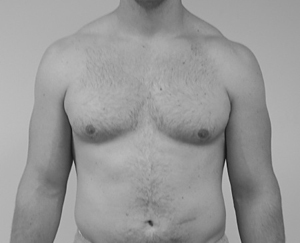
 After just six weeks of training, Ethan Brooks of the Baltimore Ravens decreased his body fat from 15.35 percent to 8.69 percent while gaining muscle.
After just six weeks of training, Ethan Brooks of the Baltimore Ravens decreased his body fat from 15.35 percent to 8.69 percent while gaining muscle.
Use the printable answer sheet to follow along as you take the course: ANSWER SHEET
92. Name the Five Lethal Foods.
1)
2)
3)
4)
5)
93. Which organization recommends adding a multivitamin to your diet.
94. Does one diet plan work for all students and athletes or can diet plans be customized based on calories:
95. What percentage of Americans eat fruit at least twice a day?
96. Is obesity among young people a growing concern?
97. True or False: Athletes should decide on a supplement program before choosing a diet plan.
98. What is a simple method to increase diet accountability?
Summary: The Be An Eleven program was created to inspire young people to fulfill their potential by inspiring them to set worthy goals, both athletic and personal. It also teaches young people to make positive choices, keep their self-respect, and become team players and role models for others.
Learning Objectives
• Understand the origins of the Be An Eleven program and why it was created
• Define the qualities of an Eleven person
• Learn the three rules for success in the Be An Eleven program
• Learn the difference between dream keepers and dream stealers
Key Terms
dream keepers,
dream stealers
BFS ONLINE ARCHIVES:
• “BFS Athlete of the Year” 2003
• “Being a True Eleven” 2003
• “Trading Places, The Ethan Brooks Story” 2003
• “How One Football Team Overcame Hazing” 2002
• “Kacey McCallister, Unstoppable!” 2002
• “One Bad Decision” 2002
• “The Dark Side of Hazing” 2002
• “Twice the Talent” 2002
• “Why Do So Many Athletes Lose Focus?” 2002
• “BFS Athlete of the Year, Conrad Ivie” 2001
• “Dream the Biggest Dream” 2001
• “A True Eleven” (P.J. Brown) 2000
• “Be An Eleven Student” 2000
• “BFS 2000 Athlete of the Year, Brock Berlin” 2000
• “Dream Keepers vs. Dream Stealers” 2000
• “Make a State-Championship Effort Today” 2000
• “The Most Powerful Motivational Tool,” 2000
• “Today I Win! The Kevin Wilson Story” 2000
• “Attributes of a Great Coach” 1999
• “Find a Way, Jeffrie Banks” 1999
• “Tag Bozied, University of San Francisco” 1999
• “Combating Drugs, Alcohol, Tobacco, Gangs and Guns” 1998
• “David Harvey-Bowen, 1998 BFS Athlete of the Year” 1998
• “Drug Testing in our Public Schools”1998
• “They Call Him Mr. Intensity” 1997
• “Class and Character” 1996
Use the printable answer sheet to follow along as you take the course: ANSWER SHEET
99. What type of goals does the Be An Eleven! program focus on? Select one: worthy goals, practical goals, simple goals
100. The Be An Eleven program comes from the fact that during a football game there are no more than 11 players from a single football team allowed on the field: True or False?
101. The people you associate with and the places you go can either help you or hinder you in accomplishing your dreams. In the Be An Eleven program, what is one more category that can be added to this list? Select one:
The products you buy,
The foods you eat,
The things you do.
Summary: The benefits of steroid use do not outweigh the risks, and many of the world’s best athletes have proved repeatedly that they don’t have to take steroids to achieve the highest levels of performance.
Learning Objectives
• Understand the risks of taking steroids
• Learn 11 reasons why steroids do not work in the long run for athletes involved in mainstream high school and collegiate sports
• Understand that athletes can reach high levels of performance without taking steroids
Key Terms
diminishing-return theory
anabolic steroids
• “The Shocking Truth About Supplements” 2005
• “11 Reasons Why Steroids Don’t Work” 2002
• “Steroids Don’t Work” 2002
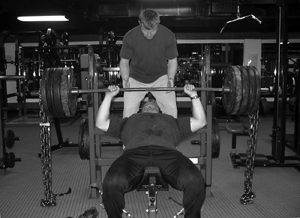 Adam Nelson lifting heavy, was able to become America’s best shot-putter without drugs
Adam Nelson lifting heavy, was able to become America’s best shot-putter without drugs
Use the printable answer sheet to follow along as you take the course: ANSWER SHEET
102. What is one possible long-term risk associated with steroid use?


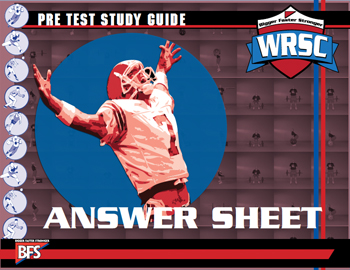
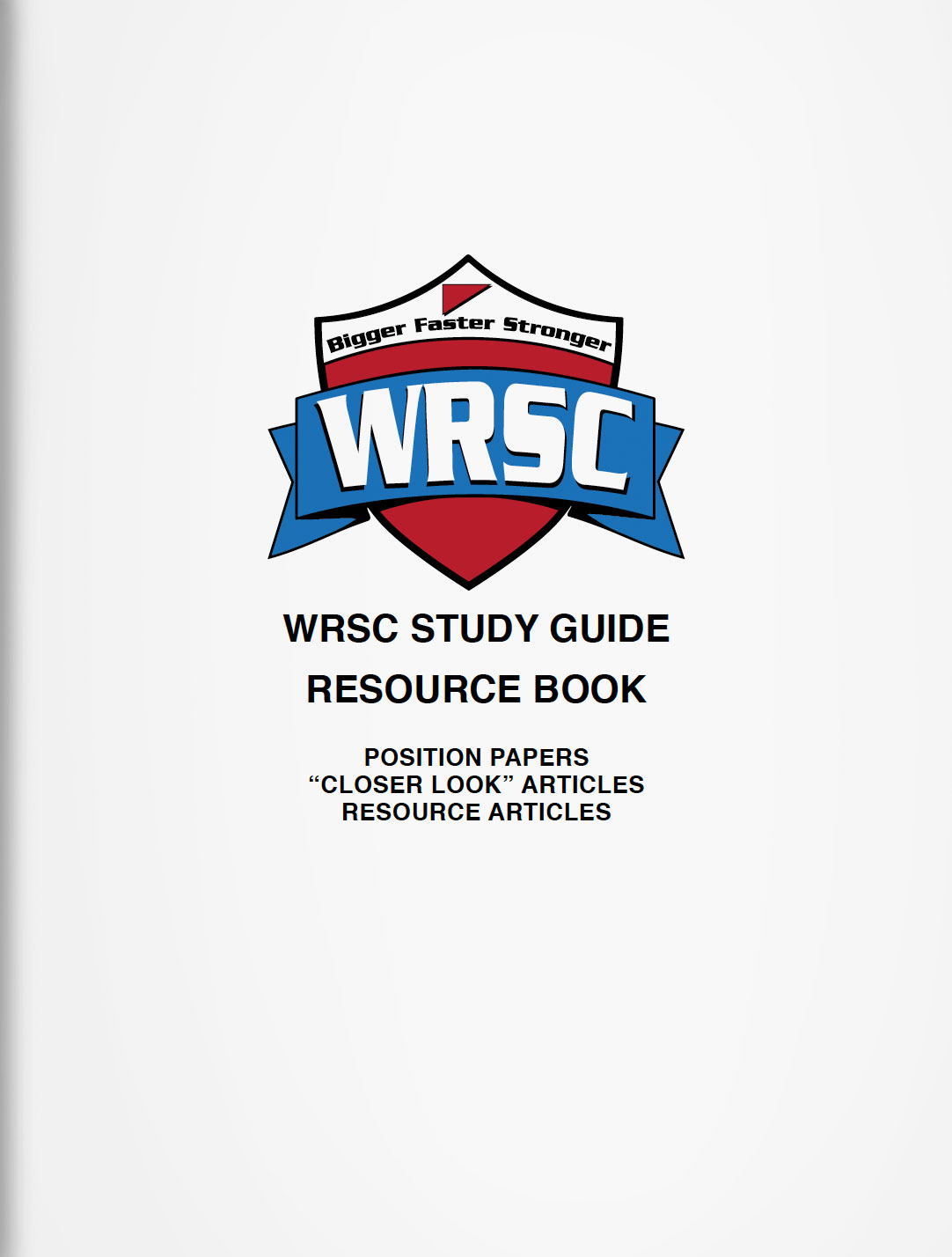
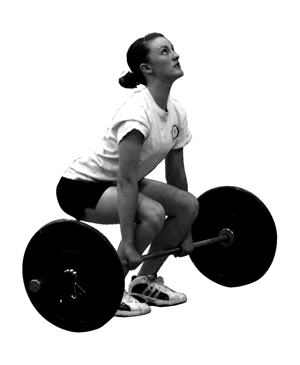


 Young athletes get a head start to athletic excellence with the
Young athletes get a head start to athletic excellence with the 








 Speed is the key in many sports, especially football
Speed is the key in many sports, especially football Many sports require exceptional levels of flexibility as demonstrated by Kristen Hasselmeier
Many sports require exceptional levels of flexibility as demonstrated by Kristen Hasselmeier 

 After just six weeks of training, Ethan Brooks of the Baltimore Ravens decreased his body fat from 15.35 percent to 8.69 percent while gaining muscle.
After just six weeks of training, Ethan Brooks of the Baltimore Ravens decreased his body fat from 15.35 percent to 8.69 percent while gaining muscle. Adam Nelson lifting heavy, was able to become America’s best shot-putter without drugs
Adam Nelson lifting heavy, was able to become America’s best shot-putter without drugs